new posts in all blogs
Viewing: Blog Posts Tagged with: kevin henkes, Most Recent at Top [Help]
Results 1 - 25 of 57
How to use this Page
You are viewing the most recent posts tagged with the words: kevin henkes in the JacketFlap blog reader. What is a tag? Think of a tag as a keyword or category label. Tags can both help you find posts on JacketFlap.com as well as provide an easy way for you to "remember" and classify posts for later recall. Try adding a tag yourself by clicking "Add a tag" below a post's header. Scroll down through the list of Recent Posts in the left column and click on a post title that sounds interesting. You can view all posts from a specific blog by clicking the Blog name in the right column, or you can click a 'More Posts from this Blog' link in any individual post.

By: Samantha McGinnis,
on 4/18/2016
Blog:
First Book
(
Login to Add to MyJacketFlap)
JacketFlap tags:
resilience,
Kathleen Krull,
free resources,
Kevin Henkes,
character development,
perseverance,
self-control,
Noah Z. Jones,
David Diaz,
Maribeth Boelts,
Lilly's Purple Plastic Purse,
Wilma Rudolph,
Wilma Unlimited,
Using First Book,
Tips and Resources,
character counts,
Those Shoes,
Add a tag
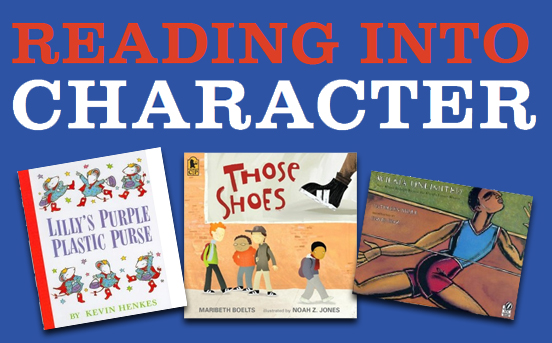
Stories can help children to develop into responsible, caring and contributing citizens.
Use the activities for each book below to teach good character traits like kindness, self-control and perseverance to your students.
To view all the books chosen and to see all the tips and activities suggested for each book, visit the Reading Into Character Section on the First Book Marketplace.
This story models self-control: being able to deny your short-term impulses in order to stay focused and pursue what is really important

Lilly loved school, until her teacher took away her fabulous movie star sunglasses, her three shiny quarters and her brand new purple plastic purse.
Ask these questions after reading the story:
- Lilly wants to show off her new things, even though she knows it’s not the right time. Why do you think is it so hard to wait when you’re excited?
- Even though Lilly loves Mr. Slinger, she is furious with him for taking away her things. Why is she so angry? Should she be angry?
This story models resilience and perseverance: honoring your word and your intentions by working hard toward an important goal, despite setbacks and challenges
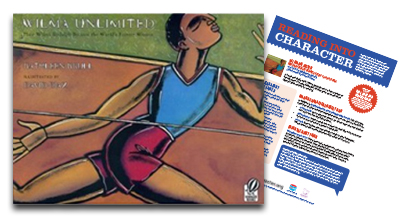
A small and sickly child, Wilma Rudolph wore a heavy brace on her leg when she was a little girl, but she grew up to win three Olympic gold medals for running.
Try this activity to learn more about resilient athletes:
Who are today’s women’s sports stars? Ask your students to choose their favorite female champions in track, basketball, tennis, soccer, and more. Research their lives. Create a Women’s Sports Hall of Fame for your classroom.
Those Shoes written by Maribeth Boelts, illustrated by Noah Z. Jones
This story models kindness and compassion: valuing others so much that you show them respect and offer help to them as a way of honoring their value

Like all the other boys in school, Jeremy wants black high tops with two white stripes. But when he finally gets a pair, he realizes that he needs to give them away.
Try this activity to practice kindness and compassion:
Investigate local charities that welcome donations of good-as-new clothing, toys, books, or other useful items. Be sure to play close attention to their donation guidelines. If feasible, organize a class- or school-wide donation drive.
Developed as a joint project with Character.org and with generous support from Disney, each hand-picked book in the Reading Into Character section is paired with a FREE downloadable tip sheet.
The post Teaching Good Character with Books appeared first on First Book Blog.

By:
Bianca Schulze,
on 3/18/2016
Blog:
The Children's Book Review
(
Login to Add to MyJacketFlap)
JacketFlap tags:
Books for Girls,
Ages 4-8,
Ages 9-12,
Picture Books,
Art,
Author Interviews,
Historical Fiction,
Yuyi Morales,
France,
Laura Ingalls Wilder,
Paris,
Artists,
Author Interview,
Kevin Henkes,
featured,
Komako Sakai,
My Writing and Reading Life,
Alexandra S.D. Hinrichs,
Renée Graef,
Seventeenth Century Books,
Add a tag
Alexandra S. D. Hinrichs, author of Thérèse Makes a Tapestry, loves exploring new places, including France, where she once studied.
By:
Bianca Schulze,
on 2/1/2016
Blog:
The Children's Book Review
(
Login to Add to MyJacketFlap)
JacketFlap tags:
Victoria Aveyard,
Viking Books for Young Readers,
Terry Fan,
The Fan Brothers,
HarperCollins,
Ages 0-3,
Ages 4-8,
Ages 9-12,
Book Lists,
Sara Pennypacker,
Kevin Henkes,
featured,
Atheneum Books for Young Readers,
HarperTeen,
Candlewick,
Razorbill,
Roaring Brook Press,
Jarvis,
Judith Viorst,
Knopf Books for Young Readers,
Cale Atkinson,
Doreen Cronin,
Megan McDonald,
David Small,
Dan Gutman,
Douglas Florian,
Simon & Schuster Books for Young Readers,
Julia Donaldson,
Jon Klassen,
Peter Reynolds,
Balzer + Bray,
Greenwillow Books,
Lydia Monks,
Lee White,
Disney-Hyperion,
Ruta Sepetys,
Marissa Meyer,
Laura Dronzek,
G.P. Putnam's Sons Books for Young Readers,
Teens: Young Adults,
Julie Falatko,
Best Books for Kids,
Best Kids Stories,
Jessica Khoury,
Feiwel & Friends,
Jess Keating,
Popular Kids Stories,
Best New Kids Books,
Melissa Landers,
Eric Fan,
Caitlyn Dlouhy Books,
Heidi Heilig,
little bee books,
Rebecca Roher,
Tundra Books,
Tim Miller,
Vikki VanSickle,
Sonia Sanchez,
Steve Light,
Tommy Greenwald,
Add a tag
Our selection of hot new releases and popular kids' books has a lot to offer!
By:
Bianca Schulze,
on 1/21/2016
Blog:
The Children's Book Review
(
Login to Add to MyJacketFlap)
JacketFlap tags:
Harry Potter,
J.K. Rowling,
Ages 4-8,
Ages 9-12,
Book Lists,
Cynthia Rylant,
Kevin Henkes,
Arnold Lobel,
Teens: Young Adults,
Family Favorites,
Else Holmelund Minarik,
Best Kids Stories,
Arwen Elys Dayton,
Henry and Mudge,
Add a tag
Arwen Elys Dayton, author of Traveler, selected these five family favorites.
By:
Bianca Schulze,
on 12/31/2015
Blog:
The Children's Book Review
(
Login to Add to MyJacketFlap)
JacketFlap tags:
Ages 0-3,
Ages 4-8,
Picture Books,
Book Lists,
Chronicle Books,
Oliver Jeffers,
Kevin Henkes,
featured,
Best Sellers,
Little Simon,
Philomel,
Greenwillow Books,
Dial books,
Herve Tullet,
Best Books for Kids,
Best Kids Stories,
Rod Campbell,
Drew Daywalt,
Best Selling Books For Kids,
B.J. Novak,
Add a tag
Our best selling picture book from our affiliate store is one of our all-time favorite books: Dear Zoo, by Rod Campbell!

Talks with Roger is a sponsored supplement to our free monthly e-newsletter, Notes from the Horn Book. To receive Notes, sign up here.
 You ask some very great writers and illustrators about how they do what they do, and it can seem as much a mystery to them as it is to you. But Kevin Henkes is one of the most astute and articulate observers of his own artistic choices I have ever met, and it was a pleasure to talk to him about the creation of his latest picture book, Waiting.
You ask some very great writers and illustrators about how they do what they do, and it can seem as much a mystery to them as it is to you. But Kevin Henkes is one of the most astute and articulate observers of his own artistic choices I have ever met, and it was a pleasure to talk to him about the creation of his latest picture book, Waiting.
Roger Sutton: This is probably the fourth or fifth picture book I’ve seen this year about waiting, and I want to know: What’s in the water?
Kevin Henkes: I don’t know! But in my work life, waiting has been very big. My next book is called When Spring Comes, illustrated by my wife, Laura Dronzek. It was originally called Waiting for Spring, and the word wait is in it seven times, which is quite a lot for a picture book. Then after that I have a picture book coming out called Egg, and the word waiting is in that one seventeen times. Children spend a lot of their time waiting. They wait in line. They have to wait their turn. They wait for their birthdays, holidays, weekends, the end of the school day. They seem to be waiting quite a lot, so I thought it would be a good idea for a book.
RS: How do you handle waiting in your own life? Are you good at it?
KH: If I’m working on a book and it’s going well, that’s a real anchor in my life and it makes everything else okay, including waiting. And I do love the time between when I’ve finished a book and when that book comes out in print. I use that time to come up with an idea for the next book, so I don’t mind it being stretched out. I know some people ache to see their book after they’ve finished the art, but I enjoy that lovely stretch of waiting. It’s a year, usually.
RS: Your work is done. It’s out of your control at that point.
KH: And it hasn’t hit the world yet, so it can still be the lovely thing that I think it is.
RS: Waiting can be nice if it’s something nice that you’re waiting for, like your little guys in this book, the pig with the umbrella waiting for rain. She knows it’s going to rain eventually, and she likes rain. It’s always good to have something to look forward to.
KH: I was at a bookstore in Minnesota, and the bookseller who introduced me said to the group of children sitting on the floor, “This book is about waiting. Does anyone like waiting?” One lone hand went up, a little girl about six who said, “I love waiting.” I noticed her throughout my presentation, because she was very present. If I said something that was mildly funny, she laughed hysterically. She was there. Then I noticed her again near the end of the signing line.
RS: Waiting.
KH: Waiting. And then she got to the table. She put her arms on the table. She leaned in to me. She narrowed her eyes, and said, “Okay, I changed my mind. I do not like waiting.”
RS: How do you prevent a book that is about anticipation — and now of course I’ve got that damn ketchup ad in my head — do you remember that, with the Carly Simon song?
KH: Yes.
RS: When a book is about anticipation, and the setting is essentially a tableau that doesn’t change, how do you prevent it from being static? Did you have to think about how to keep it dynamic?
KH: No, I thought, how do I keep this clean and simple? It was a conscious choice to not show a child in the illustrations. I wanted to keep it simple in its design, universal in its scope. There are no references to a home other than the window. There’s no wallpaper, no floor, no carpet, no furniture. At one point I toyed with the idea of having either the tail of a dog or a cat, or a dog or a cat itself coming in and out, but a lot of the work was just scaling back. I pictured this as a book in which the reader and the listener would have a lot to talk about. Where do you think the elephant came from? Or who do you think put the gifts on the windowsill? Is someone moving the figurines?
RS: You know, I do have to ask about that elephant. Jumped or pushed?
KH: I think it was an accident with the child owner. I was at the Brooklyn Book Festival, and a person came up and asked, “So, did the elephant die? Isn’t that dark for a children’s book?” And I said, “Well, no. It’s a broken figurine.” Children are people, and people deal with all kinds of loss. Some children deal with huge losses. Even if they haven’t, they’ve dealt with a popped balloon or a dropped ice-cream cone. And I think that children are good at taking from a book what they need, or not taking what they don’t need. If you’re a child who has suffered a big loss, you might interpret that spread differently than a child who has not.
RS: Or if you’re a black-hearted Irishman like me, you think the owl pushed him off the ledge.
KH: Someone else asked, “On the page where the elephant arrives, why does the pig have a come-hither look?”
RS: Wait, I have to look.
KH: I said, “Really?” This person had a whole scenario.
 RS: It is amazing what you can do to express motive and emotion with the placement of those little dots for eyes.
RS: It is amazing what you can do to express motive and emotion with the placement of those little dots for eyes.
KH: Yes. The book started because I began going to my local clay studio in 2006. I make little animal sculptures. I have many of them in my studio. One day I looked at the ones on the windowsill, and they really seemed like they were looking out the window, waiting. Originally I thought I would use my figurines and photograph them, but I decided that I’m much better at drawing and painting than I am at sculpting. And actual figurines would be fixed in a certain way, and I wanted to be able to at least change their eyes or the tilt of their heads.
RS: You do a really great job of having them retain their figurine nature, but giving them just enough movement to provide a story and emotions.
KH: That was tricky. I didn’t want them to be moving all over the place as if they were living, breathing beings, but I did want them to have enough life to make the story work. Some move more than others.
RS: When creating the groupings, was it in your mind that someone was moving them or that they were moving themselves?
KH: Oh, I always imagined a child who owned them and loved them playing with them. I guess there is always that question of what happens when you turn the light off.
RS: It’s kind of like that old science-fiction story, where people realize they’re just bugs and that someone’s controlling them from above.
KH: That whole idea plays into this story, I think. One could interpret this book many different ways.
RS: The toys are never described as waiting for their owner. It’s not a toy longing to be played with. They have each other.
KH: And it’s not a toy longing to become real.
RS: Right.
KH: Probably in the child owner’s eyes, they are real.
RS: I want to talk for a minute about my particular obsession with picture books, which is page turns. When you’re creating a book, when are you thinking about the page turns of the finished book?
KH: I always write the words first. I get them to the point where I think they’re perfect, and then I dummy, cut up the words and start playing around with them. That might be the point where I really see the physical page turns, but I’m already thinking about page turns when I write.
When I’m writing — and particularly when I was writing this book — I wanted there to be a real pattern to the words. In the beginning I’m playing with the pattern. “When the moon came up, / the owl was happy. / It happened a lot. / When the rain came down, / the pig was happy. / The umbrella kept her dry.” It sets up a series. After the characters are introduced, there’s the section where we’re getting more information about their lives. “Sometimes one or the other of them went away, / but he or she always came back. // Sometimes they slept. / But mostly they waited. / Sometimes gifts appeared.” So you have sometimes, sometimes, sometimes. And then to heighten that little series, once, and it’s big: “Once a visitor arrived…” When I wrote the line “They saw many wonderful, interesting things…” I remember thinking, oh, this is my chance to have a wordless section. Trying to decide how many wordless pages there would be and how the pages would play against one another—that was a long, hard process of decision-making.
RS: One thing I love about this book is that it keeps confounding us as to, well, what kind of book it is, exactly. Do you know what I mean?
KH: Oh, I do. Most of my books are about something small writ large: girl has purse, wants to show it to the world, and has to wait. The waiting again. When I decided that I wanted this book to be about waiting, I didn’t want it to just be about a child or a character waiting for something. I wanted it to be bigger than that. I was thinking about the changing of the seasons, the wonder of nature, sudden sadness and disappointment, those unexpected moments of joy or sadness that crop up while you are waiting for something. And I wanted it to be big enough to include birth and death.
RS: Ah, so the elephant does die.
KH: Well, of course that’s what I was thinking about. And with the matryoshka cat at the end, it’s birth.
RS: But it’s never a “you’re getting a baby sister” book either, though.
KH: No. Although — so far I’ve read it about twenty-five times across the country, from New York to California. With the elephant, there’s usually a collective “awww.” And with the cat, there’s usually an “aaahh.” But one little boy — he was about three — grabbed his head and said, “Oh, no. Not more babies!” I overheard someone saying he had newborn twin siblings at home. It was poignant and funny and I loved it. And again, it made me think everyone sees what they see. It might not be what I intended at all. But waiting for a baby is another big wait.
RS: This book swims against the tide of thinking we need a lot of action, that we need a child or at least personified animal characters. We need a big plot. I wouldn’t say yours is a particularly plotted book in the way we traditionally think of those.
KH: I would agree, but I would also say I think there is a lot going on.
RS: There’s a ton going on.
KH: For a young child, there’s a lot to talk about. I recently spent some time with my niece’s two-year-old daughter. I’m amazed at her ability to imagine and play with just about anything. And at her willingness to stay on one page of a book and really talk about it with an adult who’s asking questions. I think of this book as being pretty packed. I was a little surprised when I read a couple of reviews — which have been lovely — that said not much happens. I think a lot happens.
RS: But it’s not happening in a traditional plot trajectory.
KH: I’ll give you that.
RS: Do you think, as you’re creating a book for young children, about how it’s going to be read? Do you assume the kid is looking at it by him or herself? Do you assume an adult and a child together?
KH: I hope it works all ways. With this book I was thinking about an adult and a child, and thinking about an adult asking certain questions. But I think a child could do that on his or her own as well. I also wanted there to be a lot of space between the words, between the sentences, between the thoughts. I give space to the reader or listener to fill it in. I think that’s important. Even in books without pictures, I think we need a space between chapters. We need a space between paragraphs sometimes. It can be really powerful. What you leave out can be pretty dynamic.
RS: There’s so much mystery in this story. How did these particular figurines get there? Are they toys? Are they alive? What’s going on with them? Is there anybody else in the world besides them? I think you echo that mysteriousness by giving lots of room around each picture, around each sentence. Don’t you think that, visually, that encourages someone to wonder?
KH: I do. I used white space with this book in a way that I never have before. Both with the words — space between the words, the sentences — and the white space with the design of the book. And yet I wanted it to be very grounded. I wanted the illustrations to work together. I think of them as being echoes of each other. When I introduce each of the characters, there’s a double-page spread. “The owl with spots was waiting for the moon. / The pig with the umbrella was waiting for the rain.” And then: “The rabbit with stars / wasn’t waiting for anything in particular. / He just liked to look out the window and wait.” He’s in the lower right-hand corner of the right-hand page. When the cat comes, and the text goes through the whole series of questions — “Was she waiting for the moon? / No.” And then when I say, “She didn’t seem to be waiting / for anything in particular,” I’ve echoed the position of the rabbit. It creates a rhythm. There’s a reason to it. That part of bookmaking is what I love most. Thinking everything through and making it work together in a certain way.
RS: And then making all that work disappear.
KH: Yes. There’s that great M. B. Goffstein quote from her picture book An Artist: “You should work and work until it looks like you didn’t have to work at all.”
A spread that really pleased me when I came up with it was one of the wordless ones — the one where on the left-hand side of the page is the window with frost and on the right-hand side are the fireworks. I remember thinking the fernlike pattern of the frost was a great way to segue into the feathery nature of the fireworks. One is natural, and one is not. There’s a similarity, but there’s a tension. You could compare it; you could contrast it. You could talk about it; you don’t have to talk about it; you don’t even have to notice it, but I did, and that’s what matters. Those are the kinds of things that, when they happen, I think: I love my job.
More on Kevin Henkes from The Horn Book
The post Kevin Henkes Talks with Roger appeared first on The Horn Book.
Caldecott-award-winning-author Kevin Henkes brings us this elegant and lovingly charming book centering around toys Owl, Pig, Bear, Puppy, and Rabbit. Their lives are spent together waiting on the window sill content with observing and sharing their wonderful world. A great picture book that teaches patience, stillness, and community. Books mentioned in this post Waiting Kevin [...]
By:
Bianca Schulze,
on 9/1/2015
Blog:
The Children's Book Review
(
Login to Add to MyJacketFlap)
JacketFlap tags:
HarperCollins,
Ages 0-3,
Ages 4-8,
Ages 9-12,
Book Lists,
Brian Selznick,
Holly Black,
Kevin Henkes,
Cassandra Clare,
DK Publishing,
Katherine Applegate,
Delacorte Press,
Audrey Wood,
Dan Hanna,
Julie Murphy,
Straus and Giroux,
Farrar,
Deborah Diesen,
Don Wood,
Scholastic Press,
Balzer + Bray,
Greenwillow Books,
Dial books,
Anna Dewdney,
Pittacus Lore,
Teens: Young Adults,
Best Books for Kids,
Daniel Lipkowitz,
Leigh Bardugo,
Best Kids Stories,
HMH Books for Young Readers,
Shelagh McNicholas,
Megan H. Rothrock,
No Starch Press,
Feiwel & Friends books,
Henry Holt and Co. books,
Daniel James Brown,
Best New Kids Books,
Jazz Jennings,
Jessica Herthel,
Viking Books for Young Readers,
Nicola Yoon,
Tom Alphin,
Add a tag
Our list of the best new kids books for September highlights some amazing books from many different genres: non-fiction, reality fiction, fantasy, and even a beautiful picture book that addresses gender identity. Take a gander and let us know which titles and covers catch your eye ...
Read the rest of this post

By: Samantha McGinnis,
on 8/19/2014
Blog:
First Book
(
Login to Add to MyJacketFlap)
JacketFlap tags:
Tommy Greenwald,
First Day First Book,
Viiola Canales,
Book lists,
Books & Reading,
Marketplace,
Kevin Henkes,
Lenore Look,
Jon J. Muth,
Add a tag
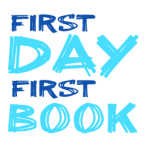 It’s time to go back to school! Get your kids excited about reading with First Book’s five favorite books for the new school year.
It’s time to go back to school! Get your kids excited about reading with First Book’s five favorite books for the new school year.
If you work with kids in need, you can find these titles on the First Book Marketplace by clicking on the pictures next to the description of each book. Also be sure to visit our Back to School section for more great reads.
 Lilly’s Purple Plastic Purse
Lilly’s Purple Plastic Purse
by Kevin Henkes
Lilly loves everything about school, especially her cool teacher, Mr. Slinger. But when Lilly brings her purple plastic purse and its treasures to school and can’t wait until sharing time, Mr. Slinger confiscates her prized possessions. Lilly’s fury leads to revenge and then to remorse and she sets out to make amends.
 Mr. George Baker
Mr. George Baker
by Amy Hest, illustrated by Jon J. Muth
George Baker (a hundred-year-old musician with the crookedy fingers) and Harry (a young schoolboy whose shoelaces always need tying) don’t seem the likeliest of friends. Yet, sitting side by side on George’s porch, waiting for the school bus to come, the two have plenty in common. They’re both learning to read, which is hard – but what’s easy is the warm friendship they share. In an inspired pairing, a best-selling author and illustrator pay tribute to the power of language and intergenerational bonds.
 Alvin Ho: Allergic To Girls, School, And Other Scary Things
Alvin Ho: Allergic To Girls, School, And Other Scary Things
by Lenore Look, illustrated by LeUyen Pham
Alvin Ho is a Chinese American second grader who is afraid of everything – elevators, tunnels, girls, and, most of all, school. He’s so afraid of school that, while he’s there, he never, ever, says a word. But at home he’s a very loud superhero named Firecracker Man, a brother to Calvin and Anibelly, and a gentleman-in-training, so he can be just like his dad.
From the author of the ALA Notable Ruby Lu series comes a funny and touching chapter book – perfect for both beginning and reluctant readers – that introduces a truly unforgettable character.
 Charlie Joe Jackson’s Guide to Not Reading
Charlie Joe Jackson’s Guide to Not Reading
by Tommy Greenwald, illustrated by J. P. Coovert
Charlie Joe Jackson may be the most reluctant reader ever born. And so far, he’s managed to get through life without ever reading an entire book from cover to cover. But now that he’s in middle school, avoiding reading isn’t as easy as it used to be. And when his friend Timmy McGibney decides that he’s tired of covering for him, Charlie Joe finds himself resorting to desperate measures to keep his perfect record intact.
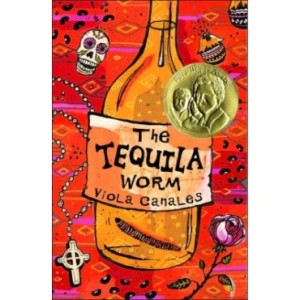
The Tequila Worm
by Viola Canales
Sofia comes from a family of storytellers. Here are her tales of growing up in the barrio, full of the magic and mystery of family traditions: making Easter cascarones, celebrating el Dia de los Muertos, preparing for quinceañera, rejoicing in the Christmas nacimiento, and curing homesickness by eating the tequila worm. When Sofia is singled out to receive a scholarship to an elite boarding school, she longs to explore life beyond the barrio, even though it means leaving her family to navigate a strange world of rich, privileged kids. It’s a different mundo, but one where Sofia’s traditions take on new meaning and illuminate her path.
The post Five First Book Favorites for Back to School appeared first on First Book Blog.

By:
Bianca Schulze,
on 7/3/2014
Blog:
The Children's Book Review
(
Login to Add to MyJacketFlap)
JacketFlap tags:
R.J. Palacio,
Best Kids Stories,
Best Selling Books For Kids,
HarperCollins,
Ages 4-8,
Ages 9-12,
Book Lists,
Chapter Books,
Candlewick Press,
Gift Books,
Kevin Henkes,
featured,
Atheneum Books for Young Readers,
Award Winners,
Katherine Applegate,
Best Sellers,
Kate DiCamillo,
Knopf Books for Young Readers,
Middle Grade Books,
Greenwillow Books,
Sharon M. Draper,
Add a tag
Seriously, there are some VERY good books on this list of best selling middle grade books; including Kevin Henkes' The Year of Billy Miller and Sharon M. Draper's Out of My Mind.

By:
Jen Robinson,
on 3/6/2014
Blog:
Jen Robinson
(
Login to Add to MyJacketFlap)
JacketFlap tags:
early middle grade,
male protagonist,
Reviews,
family,
second grade,
Newsletter,
kevin henkes,
Early Elementary School,
newbery honor book,
Add a tag
Book: The Year of Billy Miller
Author: Kevin Henkes
Pages: 240
Age Range: 7 - 10

 I had intended to pick up a copy of The Year of Billy Miller for a while when it received a Newbery Honor. This moved it higher up on my list, and I'm so glad that I read it.
I had intended to pick up a copy of The Year of Billy Miller for a while when it received a Newbery Honor. This moved it higher up on my list, and I'm so glad that I read it.
We've been Kevin Henkes fans in my house for quite some time. We have a boxed set of little picture books about Lilly and her friends that we received when my daughter was born. Lilly's Chocolate Heart was one of the first books that she knew by heart, even though she could barely pronounce the words. These days, she frequently selects other picture books by Henkes from the library. We both adore Henkes' early reader series about Penny. I've only reviewed Penny and Her Doll, but we have them all.
So, when I heard that Henkes had written a book for slightly older readers, I had high hopes. The Year of Billy Miller does not disappoint. The book is, as you would expect, about a year in the life of a boy named Biller. Specifically, it's about Billy's second grade school year. Billy's confidence at the start of the year is a bit shaky. A fall has left him with a lump on his head, and he worries about whether or not he'll be smart enough (he does forget things). Being seated next to a bossy, braggy girl does not help matters. Billy's dad, who he calls Papa, tries to reassure him by declaring that this will be "the Year of Billy Miller." And in the end, of course, it is.
The Year of Billy Miller is a perfect book for kids who are ready to move beyond early readers and entry level chapter books, but aren't quite ready for true middle grade. Although it's longer than some books written for this age range, at 240 pages, and has fewer illustrations, the structure of the book helps to keep it accessible. As, of course, does Henkes' pitch-perfect understanding of the lives of second graders.
The book is divided into four sections, each featuring an important person in Billy's life (his teacher, his father, his little sister, and his mother). Each section consists of five short chapters. The print is wide-spaced, and there are small sketches mingled directly within the text, a few per chapter. The sentences are short, and the vocabulary is new-reader-friendly, but with some stretch words, too ("embedded", "plopped").
The situations described in The Year of Billy Miller are ordinary and relatable. A misunderstanding with a teacher, a sister who damages an art project, a bout of late night fears. The situations are age-appropriate, but Henkes doesn't talk down to kids, either. Billy's father is grouchy when his art isn't going well. Billy gets blazingly angry at his sister sometimes. He figures out on his own the best way to deal with the annoying girl at school - he doesn't go to anyone for help.
Here are a few of my favorite quotes:
"Grace Cotter slipped into her chair. Billy had known Grace since kindergarten. She was so shy she seemed almost invisible. Like vacuums, her wide eyes were sucking in everything." (Page 21)
"There's a girl named Hamster in my class," he said.
"Boy or girl?" asked Papa.
"Girl."
"Maybe her parents are celebrities," said Papa. "They often give their kids unusual names."
"Huh?" said Billy. (Page 28)
"And Sal had asked Papa if she could please, please, please use glitter, which was kept in a secret hiding place out of her reach." (Page 64)
OK, those last two passages pleased me as an adult, I must admit. But all of it is kid-friendly. I also enjoyed seeing the occasional echo of Henkes' other books (the use of "Mama" and "Papa" for one thing). I think that readers who have grown up with Henkes' books will enjoy this, too.
In summary, I highly recommend The Year of Billy Miller. It would make a great classroom read-aloud for first or second graders, or a perfect bridge book for kids almost but not quite ready for more complex middle grade novels. This is a must-purchase for libraries (of course), but I'm glad that we have a copy to keep. I look forward to reading it with my daughter when she is just a little bit older. And to seeing her read it herself a bit after that. I hope that Henkes writes more books for this age range, and above, so that my daughter can grow up with his books.
Publisher: Greenwillow Books (@HarperChildrens)
Publication Date: September 17, 2013
Source of Book: Bought it
FTC Required Disclosure:
This site is an Amazon affiliate, and purchases made through Amazon links (including linked book covers) may result in my receiving a small commission (at no additional cost to you).
© 2014 by Jennifer Robinson of Jen Robinson's Book Page. All rights reserved. You can also follow me @JensBookPage or at my Growing Bookworms page on Facebook.

By:
Bianca Schulze,
on 3/2/2014
Blog:
The Children's Book Review
(
Login to Add to MyJacketFlap)
JacketFlap tags:
Ages 4-8,
Ages 9-12,
Chapter Books,
Star Wars,
Lego,
The New York Times,
Kevin Henkes,
featured,
Award Winners,
Katherine Applegate,
Best Sellers,
Kate DiCamillo,
Newbery Award Winners,
Star Wars Books,
Simon Beecroft,
R.J. Palacio,
Best Selling Books,
Best Selling Books For Kids,
John Newbery Honor Books,
Kate Howard,
Add a tag
Our latest list of current popular middle grade books features Lego books and multiple Newbery award-winning titles. The hand selected titles from the nationwide best selling middle grade books, as listed by The New York Times, feature titles by super-talents Kate DiCamillo, Kevin Henkes, Katherine Applegate and R.J. Palacio.

By: Joy Chu,
on 6/11/2013
Blog:
got story countdown
(
Login to Add to MyJacketFlap)
JacketFlap tags:
Tove Jansson,
Moomin,
Kevin Henkes,
Sophie Blackall,
diorama,
Jules,
Barbara McClintock,
Julie Danielson,
illustration classes,
Real life stories about illustrators,
taught by Joy Chu,
teaching children's book illustration,
UCSD Illustrating Children's Books Workshop with Joy Chu,
More adventures in teaching,
Timeless themes for picture books,
Zachariah Ohora,
"Chalk" by Bill Thompson,
"Kitten's First Full Moon",
2ummer 2013 UCSD Extension class taught by Joy Chu,
advent-style calendar,
Aijung Kim,
China circa 1909,
CIP data,
creating 3D models for picture book,
Fnu Anisi,
Library-of-Congress Cataloging in Publication Data,
one-phrase book summary,
studies for "Adele and Simon in China",
UCSD Extension ART 40011 class,
Add a tag
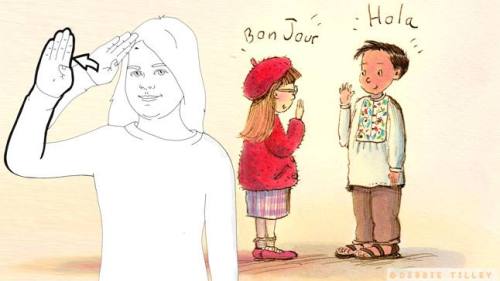
Greetings! If you live, work, or are vacationing this summer in the San Diego area, consider creating stories with pictures at my class, on the beautiful campus of UCSD in La Jolla!
Illustrating Books for Children
Instructor: Joy Chu
June 26-August 21
Wednesday evenings, 6:30pm-9:30pm
extension.ucsd.edu
Register before June 25!
 _________________________
_________________________
Inspiration is Everywhere!
During last winter’s 2013 class at UCSD Extension, I asked my students to locate the CIP book summary from any picture book, and use it as the inspiration for an eight-panel wordless picture story.
CIP (“pronounced “sip”) is book publishing jargon for the Library of Congress Publishing Cataloging-in-Publication Data. This is found within the copyright page text of every book. It features a well-constructed one-phrase synopsis of the book’s theme.
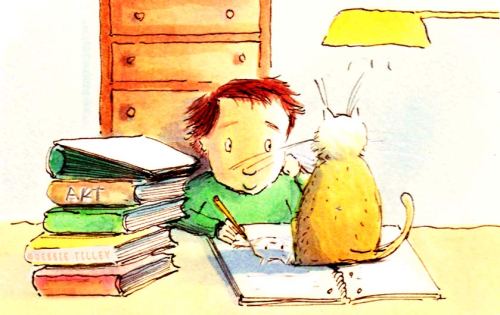
Here is an example. One student, Aijung Kim, selected the following CIP summary from Chalk by Bill Thompson. While she didn’t read the book, she knew from its cover that it featured a dinosaur. . .

“Book Summary: A wordless picture book about three children who go to a park on a rainy day, find some chalk, and draw pictures that come to life.”
Here’s what she came up with:
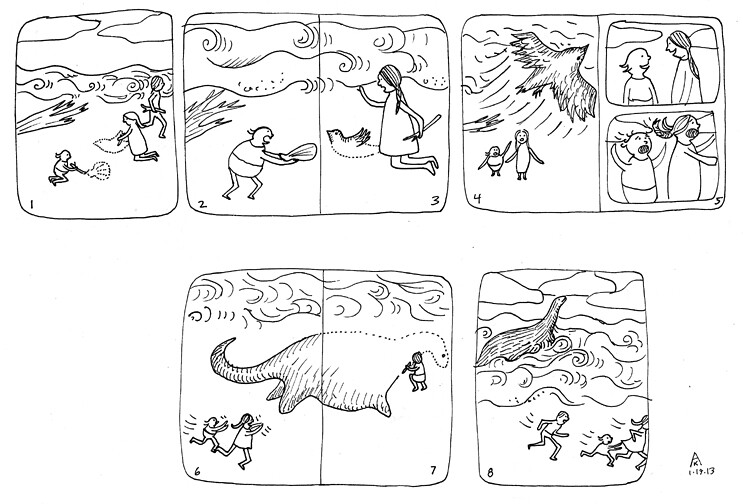
Aijung Kim’s 8-panel wordless story, created during Joy Chu’s class, Illustrating Books for Children, at UCSD Extension (right-click image to enlarge)
Another student, Fnu Anisi, enchanted by Kevin Henkes‘ Kitten’s First Full Moon, wanted to explore an eight page wordless re-telling.

Book summary: When Kitten mistakes the full moon for a bowl of milk, she ends up tired, wet, and hungry trying to reach it.
Here are Anisi’s results:
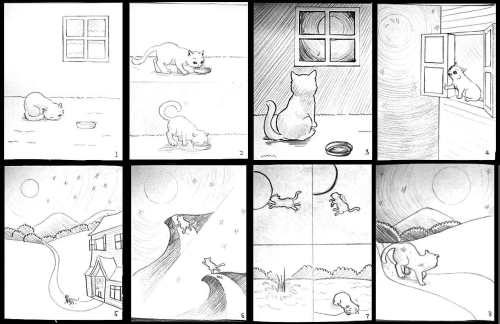
Fnu Anisi’s 8-page wordless story, created at Joy Chu’s UCSD Extension class (Right-click to enlarge)
At my upcoming summer 2013 UCSD Extension class (June 26-August 21), Illustrating Books for Children (ART 40011) we might look into creating an advent-styled calendar as a possible inspiration for creating a picture story.
Example: Look at the one Zachariah OHora created from his own story. Fun, yes?
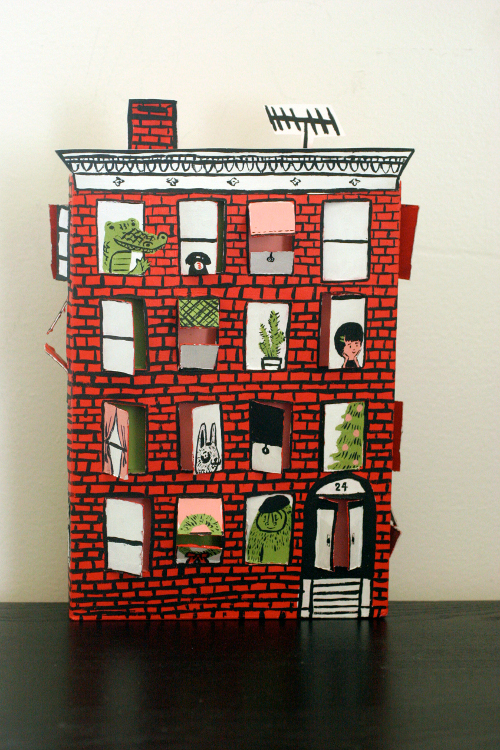
Many thanks to Zachariah OHora and Julie Danielson for sharing the above image.
Creating a 3D model for your story setting can also serve as an invaluable reference in plotting out your narrative, as well as a guide in drawing scenes from a variety of perspectives. Note how illustrator Sophie Blackall created a diorama for her work-in-progress. She can view her characters from above!

(photo © PWxyz, LLC. All rights reserved)
Author/illustrator Barbara McClintock builds cut-paper replicas of her illustrations, in composing her scenes. The following sequence is from her studies for an upcoming book, Adèle and Simon in China (all 3 photos below © Barbara McClintock)
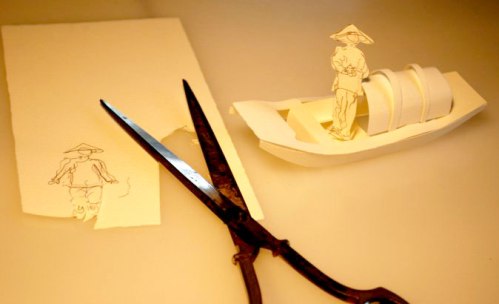
“What do those little flat boats in photos of Tongli really look like? I have to find out by building one.”—Barbara McClintock

“…Now I can draw the boats in the picture and feel some sense of confidence in what I’m doing/seeing…”
Here’s Tove Jansson, creating reference models for her fabulous Moomin stories.

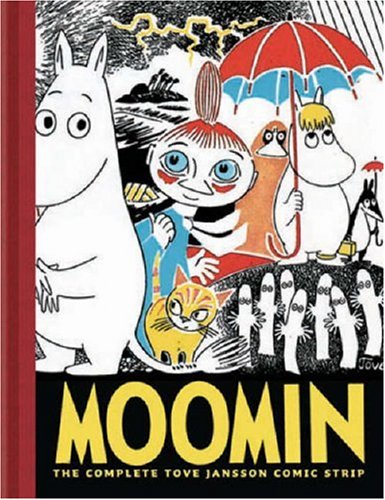
____________________
Illustrating Books for Children / Art 40011
June 26-August 21
Wednesdays, 6:30pm-9:30pm
extension.ucsd.edu
Register before June 25!


Ah, the power of guilt. As Edgar Allen Poe fans know, there's no escaping it. Penny, the mouse heroine of Henke's easy-reader series, learns this the hard way when she spots a marble on her neighbor's lawn. The marble, big, shiny and as blue as the sky, proves irresistible. It seemed to say to Penny: "Take me home." And so she does.
Guilt soon plants itself in Penny's heart, and she hides the marble in her dresser drawer. At dinner she loses her appetite when she notices how the oranges look like big orange marbles and the peas like little green ones. In bed that night she tosses and turns, and when she finally falls asleep, she dreams the marble grows so big it demolishes her dresser.
The next morning Penny makes a decision about the marble. Beginning readers, many of whom have probably struggled similarly with their conscience, will be relieved to see Penny do the right thing.
In
Penny and Her Marble, Henkes has delivered yet another winner. In the Horn Book's March/April issue, he confesses the seeds of the story. When he was five, he swiped a plastic medallion from his neighbor and was stricken with guilt. See, crime does pay!
Penny and Her Marble
by Kevin Henkes
Greenwillow, 48 pages
Published: March 2013
By:
Bianca Schulze,
on 1/24/2013
Blog:
The Children's Book Review
(
Login to Add to MyJacketFlap)
JacketFlap tags:
Ages 0-3,
Ages 4-8,
Ages 9-12,
Food and Drink,
Book Lists,
Gayle Brandeis,
Eric Carle,
Kevin Henkes,
featured,
Crockett Johnson,
Louise Fitzhugh,
Watty Piper,
Family Favorites,
Best Kids Stories,
Add a tag
We’re over the moon to have Gayle Brandeis visit TCBR. Gayle is a powerhouse mama, writer, activist, teacher, and all-around lovely person. We’re grateful to her for sharing her family’s favorite books with us.

By:
Mark G. Mitchell,
on 7/4/2012
Blog:
How To Be A Children's Book Illustrator
(
Login to Add to MyJacketFlap)
JacketFlap tags:
HarperCollins,
children's book illustration,
children's book illustrators,
Greenwillow,
children's book art,
Henkes,
PB dummy Challenge,
Illustration,
Picture book,
Kevin Henkes,
Owen,
Mark Mitchell,
Susan Hirschman,
children',
children's book author-illustrators,
children's book illustration course,
art instruction,
"Make Your Splashes; Make Your Marks!" course,
children's book illustration online course,
Add a tag
Children’s book author-illustrator Kevin Henkes received the Caldecott Medal in 2005 for his picture book Kitten’s First Full Moon (Greenwillow, HarperCollins.) But that was just a step on the journey that began more than 25 years before when, as a junior in high school, he decided to make a career of illustrating children’s books.The summer after his freshman year at the University [...]
 #66 Chrysanthemum by Kevin Henkes (1991)
#66 Chrysanthemum by Kevin Henkes (1991)
29 points
The last time I conducted this poll we ended up with results for Kitten’s First Full Moon, Lilly’s Purple Plastic Purse, even Chester’s Way but NOT Chrysanthemum. That was shocking. This time a great wrong has been righted. Mum’s the word on whether or not the other books made the list this time around.
The description from the publisher reads, “Chrysanthemum loves her name — until she starts kindergarten, which is an unfamiliar world full of short names like Sue, Bill, Max, Sam, and Joe. But it’s Victoria who really makes Chrysanthemum wilt, offering that she was named after her grandmother, which is much more important than being named after a flower. Though Chrysanthemum’s parents try to soothe her wounded soul with “hugs, kisses, and Parcheesi,” it’s not easy to find solace (and regain lost self-esteem) with all the girls on the playground threatening to “pluck” and “smell” you. Then the children meet their music teacher, charismatic Mrs. Twinkle. Mrs. Delphinium Twinkle, that is. When Mrs. Twinkle announces that she wants to name her baby the prettiest name she has ever heard, and that that name is Chrysanthemum, all the kids wish they had flower names, too. For her part, Chrysanthemum blooms once again.”
- In terms of awards, this puppy got an inclusion on the ALA Notable Children’s Book list, a listing in the Horn Book Fanfare, and a mention with the NCTE Notable Children’s Trade Book in the Language Arts.
- Browse inside the book here.
SLJ said of it, “This sensitive story will strike a chord with young children, particularly those who also have difficult or unfamiliar names.”
Kirkus liked it too saying, “Henkes’s language and humor are impeccably fresh, his cozy illustrations sensitive and funny, his little asides to adults an unobtrusive delight. Another winner from this perceptive artist.”
And Horn Book said it was, “Perfectly executed in words and illustration. . . . Few illustrators write as well as they draw; Kevin Henkes demonstrates once again that he belongs to that select company.”
A pity the Weston Woods video doesn’t have a trailer available out there. It’s one of the lovelier adaptations they’ve done and always a favorite during movie days at the library. Instead, check out this interview with Mr. Henkes in his studio:



Personally I’m fond of this c
Kevin Henkes's picture books were well-thumbed in our house back when my daughter was a child. She especially loved
Julius, the Baby of the World, which features Lilly, a mouse child who does not take well to the arrival of a baby brother. As Lilly puts it: "If he was a number, he would be zero." I spent hours reading this story to my daughter, and later, when she was school age, she'd laboriously copy the text in her childish hand. What I found amazing about her dedication to this work of sibling rivalry is that she's an only child.
Fast forward twenty years.
Penny and Her Song is Henkes's latest book and it's an easy reader. Penny, the story's young heroine is, like Lilly, a mouse child, but with two baby siblings. While this would have driven Lilly around the bend, Penny takes their existence in stride. Where Lilly was boisterous and outrageous, Penny is quiet and resourceful. She comes home from school bursting to share her song with her parents. Except she can't. The babies are asleep. Now Lilly would have thrown a tantrum on the spot. Not Penny. She goes to her room and attempts to sing the song to herself and to her glass animals. Neither does the trick. She needs a proper audience. After dinner Penny finally gets her chance and after listening, her parents and the babies join the show, singing until they are all tuckered out and ready for bed.
When I started the story I fully expected Penny to act up when she didn't get her way. How refreshing that Henkes, without moralizing, shows his readers the benefits of using self-control and patience. Short, direct sentences combined with Henkes's always delightful illustrations give us a winning easy readers children will want to read again and again. And, who knows, maybe even copy the text word for word.
Watch Kevin Henkes as he talks about Penny.
Penny and Her Song
by Kevin Henkes
Greenwillow Books, 32 pages
Published: February 2012
By:
TCBR,
on 3/14/2012
Blog:
The Children's Book Review
(
Login to Add to MyJacketFlap)
JacketFlap tags:
Music,
Ages 4-8,
Ages 9-12,
Picture Books,
Kevin Henkes,
featured,
John Manders,
Audrey Vernick,
Jeanne Walker Harvey,
Elizabeth Zunon,
Amy Martin,
R.G. Roth,
Stephen Costanza,
Leslie Staub,
Kirstie Edmonds,
Add a tag
By Nicki Richesin, The Children’s Book Review
Published: March 14, 2012
March to the Beat of Your Own Drum
It’s Music in our Schools Month and these recent titles on music (and` loneliness, getting lost, Vivaldi, and being a big sister) and so much more will make you want to groove, rock n’ roll, waltz, and bang your head. So swing to the rhythms, bounce to the beat, sway to the poetic meter, and drift away with these soulful stories.
By Amy Martin
In Amy Martin’s bold debut, a little girl becomes lost in the big city and follows street musicians until she finds her way home. Her hypnotic illustrations will pull young readers into the story where “the best songs love you back.” If Martin’s Symphony City is any indication, McMullens, the new children’s imprint from McSweeney’s, promises dazzling hits that just keep on coming. (Ages 3 and up. Publisher: McSweeney’s Publishing.)
By Audrey Vernick; Illustrated by Kirstie Edmonds
Ever dream of rocking out on stage in front of a coliseum full of fans chanting your name? Then Vernick’s new book So You Want To Be A Rock Star will send your little ones into fits of laughter as you shout, “Are you ready to rock?” Tips on posturing, strutting on stage, and signing your autograph in a haughty squiggle will put stars in their eyes. My daughter’s reading inspired her to create a rock video with a friend. For more on Audrey Vernick, check out my interview with her. (Ages 4-8. Publisher: Walker & Company.)
By Stephen Costanza
As with his previous book Mozart Finds a Melody, Stephen Costanza celebrates another great composer and creates a compelling backstory to bring his tale to life. Candida is Antonio Vivaldi’s young assistant who copies his musical notations for the Invisible Orchestra- a group of orphan musicians who mysteriously perform behind the curtain. When Vival

By: Molly,
on 2/28/2012
Blog:
the pageturn
(
Login to Add to MyJacketFlap)
JacketFlap tags:
HarperCollins,
YA,
teens,
Books,
Reviews,
young adult,
Picture Books,
YA Books,
Illustrators,
Kevin Henkes,
Greenwillow,
Greenwillow Books,
Lauren Oliver,
Add a tag
Wow– we have some really fantastic books to wish a Happy Book Birthday to today! They’re ALMOST Leap Year book babies, but not quite…

PANDEMONIUM, by Lauren Oliver. In the highly anticipated sequel to DELIRIUM, Lena completely transforms herself into a warrior for the resistance in order to push Alex and her old life far from her mind and heart. Epic and yet heart-breakingly close, you’ll savor every minute of this one.

PENNY AND HER SONG, by Kevin Henkes. Meet Penny– Kevin Henkes’ newest mouse, and his first foray into the world of beginning readers!

PARTIALS, by Dan Wells. Humanity’s only hope… may not be human at all. In this exciting thriller, a small group living on what used to be Long Island may be the only humans left after a devastating robot revolution, and Kira finds herself unexpectedly at the forefront of their survival.

Z IS FOR MOOSE, by Kelly Bingham, illustrations by Paul O. Zelinsky. Fiesty but well-meaning Moose inserts himself into every page of this ABC book that’s already garnering multiple terrific starred reviews!
This black and white book may not seem like much at first glance, but Kevin Henke's Caldecott Medal-winning Kitten's First Full Moon will soon become a favorite upon opening the cover. A little kitten, upon seeing the full moon for the first time, thinks it is a bowl of milk and sets off on an adventure to try and reach it. Kitten's expressive face, and the simple illustrations and story will delight readers of all ages.
Try also:
My Friend Rabbit by Eric Rohman
City Dog, Country Frog by Mo Willems
Bark, George by Jules Feiffer
Gossie by Olivier Dunrea
The Tale of Tom Kitten by Beatrix Potter



By: Stacy A. Nyikos,
on 11/28/2011
Blog:
Stacy A. Nyikos
(
Login to Add to MyJacketFlap)
JacketFlap tags:
computer,
Kevin Henkes,
IT,
Owen,
Faust,
writer quirks,
UVA,
security blanket,
computer lab,
Add a tag
It's been a while since I've done one of these posts. Not that I haven't thought about what it means to be a writer every second of every minute of every day. It's an occupational hazard. However, this most recent revelation is just too defining to writerdom not to share.
You might be a writer if...you still carry a security blanket.
Don't get me wrong. We're not that obvious about it. We're writers. We've given them much better names, such as Mac, Notebook Pro, Laptop, or the classic, best disguise, Computer.
As if, you sneer.
It's my computer.
That's all.I see. Let's run a little checklist, shall we?
1) Is "your computer" one of the last things you look at before you go to bed? And one of the first when you get up?
2) Do you lovingly clean its parts?
3) Do you start to feel nervous when you haven't spent time with "your computer"?
4) So do you take it with you everywhere you go?
5) Take it out of the car when it's cold or hot, just like a child?
6) Is it your ONE carry on, regardless?
7) Does your heart skip a beat when, say, your husband/child/insert name of person who clearly does not get how IMPORTANT this "computer" is accidentally unplugs your "computer" and the battery runs down and it won't fire up right away?
8) Do you plot revenge?
9) When there's a tornado, earthquake (we've had our share here in Oklahoma this fine fall) or other possible natural disaster, do you have an exit strategy that includes all essentials, such as your children, your husband, the pets, and your "computer"?
10) Most importantly, does it feel like an organic extension of you?
If you've answered yes to three or more of these questions, you may want to sit down. I have news. Your computer isn't just a computer. It's a security blanket.
That's not a bag thing. I mean, our livelihoods depend on these computers, don't they? We find creative expression - and, if we're really lucky, a paycheck - through its magical electrical circuits (Is that a good story idea?) It's no wonder we carry them with us wherever we go.
What was telling for me is that I didn't always feel this way about my computer. The joined-at-the-hip feeling started somewhere in the middle of my dissertation, i.e. my first official written creation. When I was six months pregnant with my first child (actual, human child), I was knee deep in the dissertation. I had six of eight chapters almost complete. I got up, went through my usual morning routine, then sat down at my computer. I opened the dissertation file, which I had backed up on two different external drives, and in individual chapters just to make sure I didn't lose anything. Stories of other grads who'd lost whole dissertations due to lazy back up methods were more than urban myths in grad schools. They were nightmares.
One that became real for me. None of the files would open.
Panic. Major, major panic. The kind that was so intense my daughter didn't move for six hours.
To make a long, painful story somewhat less painful for those of you who can imagine what it's like to lose 40,000 well-crafted words, complete with illustrations, I ended up at the computer lab at UVA. Many techs later, I was at the IT guru's desk, the last resort, the nuclear option of technical difficulties. He tried everything. Nothing worked. Then he made a call. A friend of a friend had an experimental version of the latest Word program. There were no promises but...
In that moment, I understood Faust only too well.

By:
Betsy Bird,
on 11/20/2011
Blog:
A Fuse #8 Production
(
Login to Add to MyJacketFlap)
JacketFlap tags:
Make Way for Ducklings,
Lilly's Purple Plastic Purse,
Crockett Johnson,
Robert McCloskey,
Harold and the Purple Crayon,
Don't Let the Pigeon Drive the Bus,
books to films,
George and Martha,
books to television,
Mo Willems,
Uncategorized,
James Marshall,
Kevin Henkes,
Ezra Jack Keats,
Add a tag
I can’t pinpoint what it was that made me think of this. In this day and age with children’s picture book characters appearing as television and movie characters every other minute, to say nothing of the new deals being made with the names of classics we all grew up with, it’s a lot easier to pinpoint the ones that haven’t been appropriated by the entertainment industry. With producers more than willing to suck every little last bit of goodwill from a property, here is a list (insofar as I know) of the characters that haven’t been seen in their own television shows / CGI films. Oh, and I should note that when I say these haven’t been adapted I am not referring to the multiple very clever stage shows made of each one of these. Theater is the classy version of what I’m envisioning here:
 - The Very Hungry Caterpillar by Eric Carle : Not that you can miss him. If you don’t own Caterpillar bedsheets or hand puppets then maybe you have him on your curtains and wallpaper. I’m no different. My child is proud to sport Caterpillar shoes and eats from Caterpillar plates. Still, we haven’t yet seen the Caterpillar Saturday morning cartoon show. And it would be soooo easy to do so. The Caterpillar and his friends (The Very Quiet Cricket, the Very Grumpy Ladybug, the Very Lonely Firefly, etc.) have a variety of preschool-friendly adventures, usually involving counting, colors, and days of the week. Oh, you just know some exec has pitched this to Carle himself. Fortunately the fellow doesn’t need the dough.
- The Very Hungry Caterpillar by Eric Carle : Not that you can miss him. If you don’t own Caterpillar bedsheets or hand puppets then maybe you have him on your curtains and wallpaper. I’m no different. My child is proud to sport Caterpillar shoes and eats from Caterpillar plates. Still, we haven’t yet seen the Caterpillar Saturday morning cartoon show. And it would be soooo easy to do so. The Caterpillar and his friends (The Very Quiet Cricket, the Very Grumpy Ladybug, the Very Lonely Firefly, etc.) have a variety of preschool-friendly adventures, usually involving counting, colors, and days of the week. Oh, you just know some exec has pitched this to Carle himself. Fortunately the fellow doesn’t need the dough.
 - Peter and friends from the books of Ezra Jack Keats : They have been adapted into books by authors other than Mr. Keats, and in the 70s there were some pretty awesome live action short films made of their stories. However, there’s been nothing recent, which raises my suspicions. Is there a belief that stories about inner city kids wouldn’t sell or are the characters too enmeshed in their era to be timely? I suspect the former but I’m naturally suspicious. Could just be the Keats estate is full of classy folks unwilling to sell out.
- Peter and friends from the books of Ezra Jack Keats : They have been adapted into books by authors other than Mr. Keats, and in the 70s there were some pretty awesome live action short films made of their stories. However, there’s been nothing recent, which raises my suspicions. Is there a belief that stories about inner city kids wouldn’t sell or are the characters too enmeshed in their era to be timely? I suspect the former but I’m naturally suspicious. Could just be the Keats estate is full of classy folks unwilling to sell out.
 - The Pigeon from Don’t Let the Pigeon Drive the Bus by Mo Willems – Or Elephant and Piggie for that matter. This isn’t entirely surprising, of course. Mo’s not exactly a small town rube. He knows the television world well having worked there for a while (to say nothing of this) and I wouldn’t be surprised if the multiple folks courting him have been rebuffed mightily over the years. Like Carle, Willems doesn’t need ‘em. His Pigeon does well enough on its own.
- The Pigeon from Don’t Let the Pigeon Drive the Bus by Mo Willems – Or Elephant and Piggie for that matter. This isn’t entirely surprising, of course. Mo’s not exactly a small town rube. He knows the television world well having worked there for a while (to say nothing of this) and I wouldn’t be surprised if the multiple folks courting him have been rebuffed mightily over the years. Like Carle, Willems doesn’t need ‘em. His Pigeon does well enough on its own.
- Harold from Harold and the Purple Crayon by Crockett Johnson – Short animated films of Harold have been made, but I live in fear that . . . oops. Didn’t see this. Just found out about
7 Comments on It’s Only a Matter of Time: Licensed Properties That Haven’t Made the Leap to Film, last added: 11/22/2011








 You ask some very great writers and illustrators about how they do what they do, and it can seem as much a mystery to them as it is to you. But Kevin Henkes is one of the most astute and articulate observers of his own artistic choices I have ever met, and it was a pleasure to talk to him about the creation of his latest picture book, Waiting.
You ask some very great writers and illustrators about how they do what they do, and it can seem as much a mystery to them as it is to you. But Kevin Henkes is one of the most astute and articulate observers of his own artistic choices I have ever met, and it was a pleasure to talk to him about the creation of his latest picture book, Waiting. RS: It is amazing what you can do to express motive and emotion with the placement of those little dots for eyes.
RS: It is amazing what you can do to express motive and emotion with the placement of those little dots for eyes.







 _________________________
_________________________








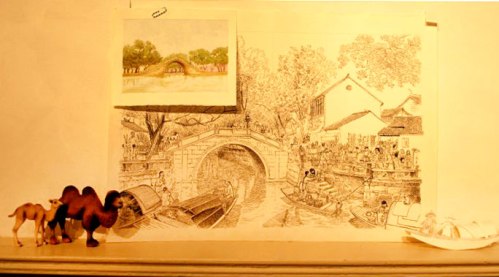








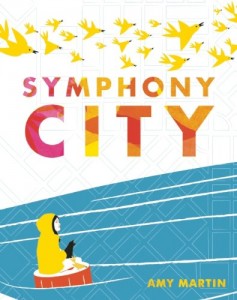
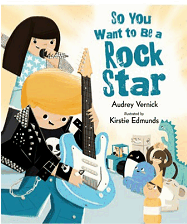
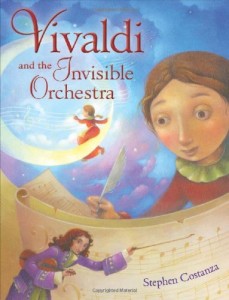










I was thinking just the other day about the when I was six-year-old and stole a pencil eraser on my family's Saturday trip to Woolworth's. The guilt was so excruciating that I snuck it back the next week. But was it guilt or fear?